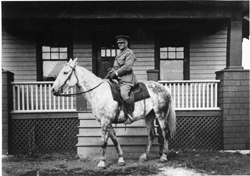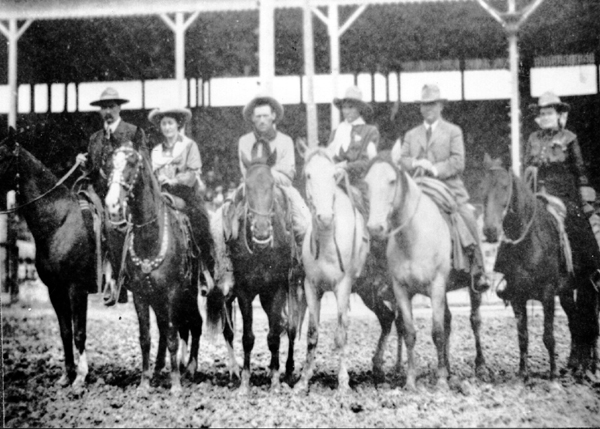 William Hall Ogle was a gentleman, a cowboy and the first president of the Saskatchewan Stock Growers Association. He was born into the aristocracy, became a cowboy by choice and the president of the Stock Growers by the choice of others.
William Hall Ogle was a gentleman, a cowboy and the first president of the Saskatchewan Stock Growers Association. He was born into the aristocracy, became a cowboy by choice and the president of the Stock Growers by the choice of others.
At the age of eighteen Ogle came to Cannington Manor in search of adventure. However, life at Cannington was little more than an imitation of the life he had known in England with its foxhunts and cricket matches, so the young man set off in search of his own adventures.
That same year, 1888, he arrived in Wood Mountain where he had his first experience riding a bronc in the Canadian West. To quote Ogle’s memoirs; “Fred Brown put a job up on me. An Indian brought some horses into the settlement and Fred caught up a buckskin, saddled him up good and tight with my brand-new California saddle. He held his hands over the horse’s eyes while I got on and then he hit the pony on the rump. I pulled leather for all I was worth and I managed to stay. I turned the horse into deep snow and kept going for an hour and I got the best of him. After, Fred told me that the horse had killed a man so he had been able to buy it cheap.”
In that manner, one greenhorn proved himself. Ogle took to ranch life and gained experience breaking horses on the Maclean ranch in Montana. A year later he worked with the N—N ranch on its spring roundup of cattle. As he himself said, he hoped to learn the best ranching methods from the men who knew the business.
By 1893, Ogle had his own ranch headquarters on the Milk River near the mouth of the Frenchman River. It was during this time that he took a Sioux girl as his wife. Soon sheepmen and homesteaders were edging into the area so Ogle returned to the Wood Mountain area where he established ranching operations, based on large federal land leases.
While Ogle did raise some cattle, he was particularly interested in horses. He imported high grade Belgian stallions for breeding stock. Most of the horses he raised were sold to homesteaders. His reputation as a stockman garnered him an invitation to be a judge at the very first Calgary Stampede in 1912, and was asked to judge at Winnipeg.
Ogle’s fondness for horses is revealed in the story of Brownie. Brownie, branded with the V5 on the right jaw was Ogle’s favourite mare. As such, she was often stabled during the winter. One spring Brownie, along with a band of about seventy-five mares disappeared. Ogle searched but no trace was found of the band. Late the next winter a straggly bay mare wandered into Ogle’s barnyard during a March storm. When the stable door was opened the mare went straight to one particular stall. Jimmy Ogle, who was just a youngster, said, “I think the mare is old Brownie.”
The mare was very thin and Ogle wasn’t prepared to believe Brownie could be in such poor condition. The mare was taken from the barn but at the first opportunity, she entered and went straight to the same stall. For an experiment, the mare was taken out again and for a third time she went back to the same stall. Ogle conceded the mare was likely Brownie, but to be certain the long straggly hair was clipped and the brand was revealed. It was a VB— a simple alteration from Ogle’s V5 brand and there was evidence of tampering.
Talk went around and it wasn’t long before Ogle was informed of a band of VB— horses south of Miles City, Montana. Investigations proved those horses belonged to Ogle. So it was a little bay mare that led to the recovery of a fine band of brood mares.
During this time the influx of homesteaders and their plows were rapidly turning the country upside down with their plows and Ogle raised his concerns for the preservation of the grasslands with fellow ranchers near the now city of Moose Jaw.
They decided that ranchers needed an association to lobby on their behalf and as a result, the Saskatchewan Stock Growers Association was organized in July 1913 and the first president and voice of the stockmen was William Ogle.
He was very active while in office; making several trips to Ottawa, lobbying to reinstate lease tenures for a minimum of ten years so ranchers could plan for their future and to preserve as much as possible as native grasslands.
He returned to England to bear arms in the First World War, and after that returned briefly to dispose of some of his livestock and his property. At that time he had about 1000 horses and 650 cattle. He left part of his holdings for his grown family who remained at Wood Mountain.
Just as he had often longed for England while in the West, he longed for Canada and the Great Plains while in England. The West that he remembered was not cut with furrows; it was the West of grass and sage.
After serving in two wars, William Ogle died in 1953.
